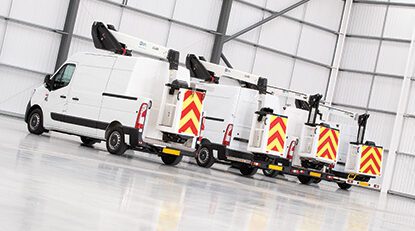Van-Mounted Cherry Picker or Truck-Mounted Cherry Picker – What’s the Difference
In a world filled with too many options, making the right decision can be overwhelming. Even after signing the contract and starting the work, buyer’s remorse can lead you to second-guess your entire strategy. That’s where we come in. Before you reach that dreaded stage of feeling like you’ve made a big mistake, CPL is here to guide you in determining which solution is best for your business, your operators, and your long-term goals.
With expertise in both van-mounted access platforms and truck-mounted options, we are here to help you make the right choice at the right time. Over the years of manufacturing vehicle-mounted access platforms in the heart of the UK, we have worked closely with arborists, utilities, telecommunications, street lighting, and many other industries that support UK infrastructure. Through this experience, we have gained valuable insights into what operators want and need to get the job done efficiently.
Let’s start with the basics: when purchasing a cherry picker (MEWP), ensure all these criteria are met before proceeding.
Now let’s take a closer look at the difference: Van-Mounted Cherry Picker VS Truck-Mounted Cherry Picker.
What is a Van-mounted/Truck-mounted Cherry picker?
A van-mounted cherry picker consists of three main components: a commercial van chassis (such as those from Renault, Ford, or Mercedes), an articulated boom arm (which may include a jib), and a work platform or basket. In the case of a truck-mounted cherry picker, the only difference is that the chassis is replaced with a truck. This setup is classified as a Mobile Elevating Work Platform (MEWP 1B, IPAF).
Both classifications are available in various heights from numerous suppliers. So, it’s essential to understand the first set of criteria before exploring your options, as this will help you narrow down the best choice.
To effectively equip your operator, it’s important to understand their requirements. If a mobile workshop is a key decision-making criterion, a van-mounted solution is the best choice. These vehicles typically have a smaller footprint, making them ideal for urban areas and tight working environments. They also offer excellent potential for storage and workbench space inside, facilitating quick setups with everything needed in a single vehicle. However, it’s essential to pay attention to the payload capacity, as this can significantly impact what can be safely carried inside.
From Vans to Trucks
Most van-mounted MEWPs (Mobile Elevating Work Platforms) typically have a gross vehicle weight (GVW) of 3.5 tons, similar to CPL’s 3.5-ton type-approved range.
Operators do not need a special license to drive them, which helps to reduce operational and training costs. For smaller vans, such as the KL21B, which does not have outriggers, the footprint is even more compact.
If you require a higher payload, the KL42 is the best option, offering a capacity of 1400 kg. However, keep in mind that the KL42 has a GVW of 4.5 tons, so your team will need a larger license to transport it. Generally, van-mounted MEWPs do not reach the same working heights as truck-mounted ones, with maximum heights around 10 to 17 meters, which is suitable for most jobs.
Van-mounted platforms are ideal for street lighting, telecoms, facilities management, and signage.
Truck-Mounted Cherry Pickers
When considering truck-mounted options, the working height is what truly sets them apart. CPL supplies truck mounts with working heights ranging from 12 to 90 meters, covering most heights that operators will need to reach. A significant advantage of a higher working height is the extended maximum outreach.
For example, the CPL 20 is built on a 3.5t Iveco chassis, making it comparable to most van-mounted platforms. However, it offers a higher working height and greater outreach (19.9m by 8.4m), though this comes at the expense of interior workspace and a smaller footprint.
In contrast, the Palfinger P900 features an impressive working height of 90m and a 32m outreach. It occupies a different sector of specialised equipment, particularly because its gross vehicle weight (GVW) is 48t, making it suitable for heavy-duty applications. At this weight, you have the option to add a workshop, but this will significantly increase purchasing costs. These units at higher heights generally range from £100,000 to £200,000, with prices escalating as the specifications increase
Truck-mounted platforms are ideal for heavier-duty use, more payload, ideal for construction or power line maintenance
Find the Right Fit for Your Work
The choice generally depends on the height and reach required to complete the job. Once you determine that, you can begin to assess the licenses your operators need to drive the platforms. Additionally, consider whether you will need storage space or even a workshop.
However, it doesn’t stop there. With trailer-mounted, tracked options and even scissor lifts, choosing the right access platform can be overwhelming. That’s why our team is here to help.
Explore our full product range | Check out the Configurator | Contact our team for assistance selecting your next MEWP.













